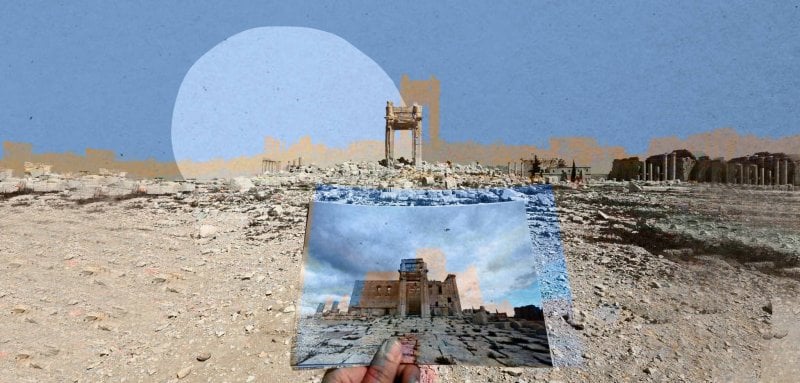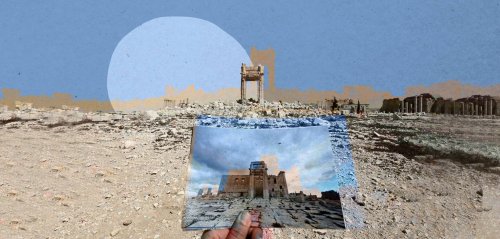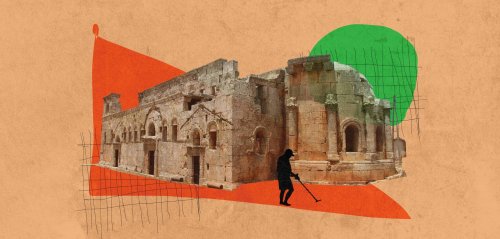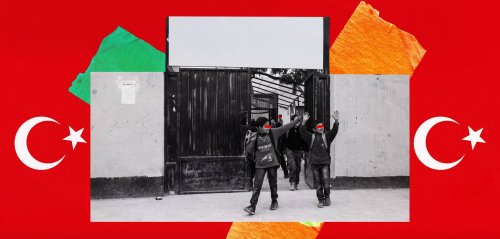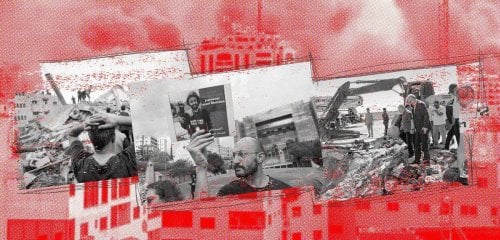"Tourism" in Syria has become the lifeline of the country’s regime, providing a renewed source of high revenue alongside oil. Syria boasts over 4,500 archaeological sites; religious and spiritual tourism locations during all four seasons; long coastlines along the warm waters of the Mediterranean Sea; and rivers and diverse environments of mountains, deserts, and forests.
These revenues peaked in 2010, with approximately 9.45 million tourists visiting Syria, making tourism the second largest source of foreign currency after oil exports. However, the outbreak of protests in 2011 severely damaged the projects, tourist facilities, and archaeological sites that once attracted tourists. After reclaiming vast areas of Syria, the regime has overly emphasized interest in the tourism sector despite the significant damage inflicted.
"Dark tourism" refers to trips undertaken by individuals or groups to dangerous or destroyed archaeological sites associated with death and war. The Syrian regime has facilitated this for content creators and YouTubers. It aims to export a different image of the country in terms of its security, cost of living, and central message of "victory over terrorism."
The resurgence of tourism amid war
The loss of essential components of Syrian tourism, intertwined with the new economic, security, and political factors shaped by the Syrian war, has prompted Syrian state media to heavily promote its return. This is despite Syria being ranked as the third least peaceful country in the world by the Institute for Economics and Peace.
According to Syria's Ministry of Tourism, over 2.17 million tourists from Arab and foreign nations visited Syria in 2023, contributing 125 billion Syrian pounds to the regime's treasury that year (1 billion is approximately $400,000 US dollars). This marked a 120 percent increase from 2022, when Syria received around 2 million visitors, including 1.75 million Arabs and 250,000 foreigners, with 213,000 visiting holy sites.
Dark tourism
"Dark tourism" refers to trips undertaken by individuals or groups to dangerous or destroyed archaeological sites associated with death and war. The Syrian regime has facilitated this for content creators and YouTubers with the aim of exporting a different image of the country in terms of its security, cost of living, and, most importantly, its message of “victory over terrorism.”
The loss of essential components of Syria’s tourism sector during the war has led Syrian state media to heavily promote the return of tourism, despite Syria being ranked the third least peaceful country in the world by the Institute for Economics and Peace
However, accessing all tourist sites remains challenging for many visitors, as numerous historical areas are restricted to Russian and Iranian military personnel. Security clearances also impose further restrictions, limiting tourists primarily to markets, natural landscapes, and a few partially destroyed neighborhoods.
According to ASharq Al-Awsat newspaper, citing sources from the Syrian tourism sector, “no foreign tourists have visited archaeological sites since the war began, because foreigners visiting Syria are predominantly Iranian and Russian military personnel or civilians affiliated with government organizations”. Security clearances also limit local and expatriate tourist groups from visiting sites like Palmyra, which suffers from severe damage and destruction, poor services, and high transportation costs.
Palmyra, located in the Syrian desert, is considered the oldest historical city in the world and a UNESCO World Heritage Site. Some of its notable landmarks include the renowned ancient Palmyra Castle, Temple of Bel, Baalshamin and Nabu. The archeological site also contains baths, the senate hall, the public market, tower tombs, and the Monumental Arch, also called the Arch of Triumph, which ISIS destroyed when it took the city in 2015. The arch was subsequently restored in 2022 through collaboration between Syria's Directorate-General of Antiquities and Museums, the Syrian Trust for Development, and the Institute for the History of Material Culture at the Russian Academy of Sciences.
In an interview with Raseef22, academic and researcher Adnan Almohamad pointed out that Russians and Iranians are engaging in suspicious excavation activities in Palmyra under the guise of restoration. Even staff from the Syrian Directorate-General of Antiquities are not allowed entry without special permission. Only official foreign or local delegations, using their visits to promote the regime and advertise a return to stable, normal life in Syria, receive access. Consequently, it is difficult to obtain permits to enter such areas.
According to Almohamad, special security protocols are established for these delegations, which are accompanied by security officers who facilitate tourist bus movements in military presence areas. Buses are directed away from sites showing significant damage, restricting access to numerous archaeological sites where substantial destruction is evident. Despite these challenges, the regime has achieved a degree of recognition, albeit informal, as foreign tourists visit at their own expense and responsibility, with no state-sponsored tourism programs available.
According to Syria’s Ministry of Tourism, over 2.17 million tourists from Arab and foreign nations visited Syria in 2023, generating a tourism revenue of 125 billion Syrian pounds for the regime (~$9.6 million). This marked a 120 percent increase from the previous year, when Syria received approximately 2 million visitors, including 1.75 million Arabs and 250,000 foreigners, and 213,000 visited religious sites.
According to Almohamad, the regime still has the potential for growing a tourism sector in areas under its control. It remains active in many regions of the world through exhibitions, visits, and cultural agreements. Despite the lack of pressure from the opposition to prevent the regime from using tourism funds in ways that contribute to displacing the Syrian people, the regime promotes Syria as safe and ready for tourism, disregarding the millions displaced within and outside the country.
Almohamad’s assertions are supported by a report from the Syria Justice and Accountability Centre in July 2021, suggesting that tourism could potentially benefit some local Syrians. However, indiscriminate mass promotion without understanding the reality of the situation is irresponsible at best, and potentially harmful to those still living daily under violence, poverty, and oppression.
Religious tourism
The regime recently introduced measures to encourage Shia Muslims to visit holy sites and shrines. The Central Bank of Syria issued a directive allowing Iranian visitors entering Syria through the Iranian Hajj and Pilgrimage Organization to pay for accommodation in Syrian pounds. This was followed by a decision to lift security clearance and pre-entry visa requirements for Iraqi citizens visiting Syria for the first time.
Religious tourism represents a major component of the tourism sector. In 2011, the Ministry of Tourism recorded one million Shia visitors from Iran alone, with the previous year seeing 213,000 Iranians visiting religious sites. Government statements indicate significant visits during the same period from Iraq, Iran, and Bahrain, primarily for religious and medical purposes.
South of the capital Damascus, the Shrine of Sayyida Zainab has become Syria's equivalent of Najaf, witnessing a large influx of Shiites visiting the holy site. Meanwhile, the Shrine of Sayyidah Ruqayya near the Umayyad Mosque in Damascus ranks as the second most important shrine, followed by the Shrine of Sakina bint Ali bin Abi Talib in Daraya, the Shrine of Sakina bint Hussain in Bab al-Saghir Cemetery in Damascus, and the Shrine of Hujr ibn Adi in Adra near Damascus.
Palmyra, located in the Syrian desert, is considered the oldest historical city in the world and a UNESCO World Heritage Site. It houses the ancient Palmyra Castle, ancient temples, and the Monumental Arch, which ISIS destroyed when it took the city in 2015. The arch was subsequently restored in 2022 through collaboration between Syria's Directorate-General of Antiquities and the Institute for the History of Material Culture at the Russian Academy of Sciences.
Expatriates loyal to the regime revive tourism
In November 2022, The Guardian reported that the Syrian regime initiated a coordinated campaign to convince investors and tourists that Syria has much to offer foreign visitors. The article questioned whether tourists would want to vacation in a country where thousands of civilians have been killed over the past decade.
The report quoted disinformation researcher Sophie Fullerton, who emphasized ethical travel, stating, "People should be able to travel where they want but you need to engage in ethical travel and you need to be mindful of what has happened there. Those who come and rewrite the last 10 years of history do a disservice to the Syrians who can’t go back."
Almohamad notes that the Syrian tourists crowding airports and border crossings are primarily expatriates loyal to the regime or Syrians visiting family who are not sought after by security agencies. These individuals left Syria not as regime opponents but individuals escaping work or the many hardships of war. Before visiting Syria, they undergo security checks to determine if they are wanted there. They constitute the largest portion of Syria's visitors, followed by Arab tourists from Gulf states, Jordan, Iran, Iraq, and Lebanon. Foreign tourists are fewer in number, estimated in the hundreds. However, their numbers are increasing gradually.
According to Almohamad, these foreign tourists visit Syria under a regime-sponsored tourism and security program. Their visits are approved by security agencies, particularly for those who accept the regime's narrative of fighting terrorism and portraying Syria as safe.
"The ancient ruins in the Syrian Jazira Region, encompassing the governorates of Deir ez-Zor, Raqqa, and Hasakah, are richer and more profitable than its oil. It is the most promising area in the world, with each of the thousand hills of Hasakah telling a story of a rich cultural and archaeological heritage filled with rare finds."
Oil over tourism in northeast Syria
Given the unique archaeological treasures in the Jazira Region, Italian archaeologist Paolo Emilio Pecorella emphasizes the global significance of the Jazira Region, which includes the governorates of Deir ez-Zor, Raqqa, and Hasakah. He states, "The ancient ruins in the Syrian Jazira Region are richer and more profitable than its oil. It is the most promising area in the world, with each of the thousand hills of Hasakah telling a story of a rich cultural and archaeological heritage filled with rare finds."
After 2011, various factions and organizations alternated control over the Jazira Region in Syria, ranging from Syrian opposition groups to ISIS, al-Nusra Front, and the US-backed Kurdish-led Syrian Democratic Forces (SDF). The common factor among these groups was their regular targeting of archaeological sites and hills, looting their contents, bulldozing them, and smuggling them out of the country.
One such site is Qalaat Jabaar, a highly significant archaeological location in Syria and a vital part of the northern archaeological map. Situated on the left bank of the Euphrates River, about 53 kilometers from Raqqa city, it now stands as an island in the middle of a lake formed by a dam on the Euphrates River. The castle's entrances have been restored, making it accessible to visitors.
The castle is known as the original burial place of Sultan Suleyman Shah, the grandfather of Osman I, the founder of the Ottoman Empire. As battles with ISIS intensified, a large group of Turkish military elements entered through Kobani–Ayn al-Arab in February 2015, relocating Suleyman Shah's remains to a new location inside Syrian territory. They moved them near the village of Ashma, close to Ayn al-Arab, after reaching the Qarah Qawzaq Bridge, 35 kilometers south.
The castle served as a launching point for ISIS attacks before its defeat, overlooking the largest prison managed by the extremist organization near the Euphrates Dam. This resulted in significant damage during military operations and the cessation of restoration work and missions since 2010.
After 2011, various factions and organizations alternated control over the Jazira Region in Syria, ranging from Syrian opposition groups to ISIS, al-Nusra Front, and the US-backed Kurdish-led SDF forces. The common factor among these groups was their regular targeting of its archaeological sites and hills, bulldozing them, looting their contents, and smuggling them out of the country.
"Today, alongside the citadel of Qal'at Najm, the castle attracts visitors from surrounding areas who seek to escape city congestion and enjoy the tranquility available at these riverbank sites with their rich vegetation," says Zardasht Isso, deputy chairman of the Culture Authority in North and East Syria, affiliated with the Autonomous Administration (AANES) of the SDF.
Isso informed Raseef22 that the culture authority has installed a metal fence at the top of Qalaat Jabaar to protect tourists from entering hazardous areas. They have rehabilitated the stairs leading up to the castle's roof by paving them with bricks from the furnaces of the archaeological site of Harqalah, which produces baked bricks. Additionally, they have rehabilitated and modified some drainage points for rainwater in the castle, provided amenities to help visitors enjoy the area as much as possible, and posted guards to protect the site from break-ins or vandals. This was especially key after all interventions and maintenance stopped in 2012.
Isso acknowledges that tourism in SDF-controlled areas is currently weak, especially in terms of foreign and external tourism, due to security conditions. He says they are currently assessing these sites for future investment and conducting studies to preserve these archaeological and tourist treasures. They aim to carry out restoration work within the limits of their modest financial resources.
Domestic tourism in opposition-held areas: Afrin as an example
In addition to the presence of some archaeological monuments, northwestern Syria is distinguished by its natural landscapes. The relative calm in this region has contributed to the revitalization of domestic tourism, providing the only outlet for residents under the control of the Syrian opposition. Some recreational facilities have been revived, benefiting from the area's rivers, lakes, springs, mountainous masses, and forests, particularly in the countryside of Afrin and Idlib. Both are located on the Syrian-Turkish border. This setting, combined with its scenic beauty, makes these areas distinctive tourist destinations and summer resorts.
During the regime's rule and the period of SDF control over it from 2012 to 2018, Afrin suffered from significant neglect in the tourism sector, with limited investment despite its vast potential. Afrin includes many sites of historical importance, such as Sam'an Castle; the Tel Ain Dara temple; the archaeological villages of Mount Laylun, Barad, Kimar, Soghana, Kafr Nabi, and Basuta Castle; and the site of the city of Cyrrhus, in Arabic known as Nabi Huri. Nabi Huri is one of the most important archaeological sites in Afrin, combining historical artifacts with recreational areas. It features an archaeological castle, baths, and cemeteries, and is distinguished as an important religious and military center. In 2021, the Directorate of Religious Affairs of the Hatay Province in Turkey undertook restoration works on the shrine located there. The Nabi Huri area has become the most attractive area for locals. In addition to its archaeological landmarks, the Sabun River, with its breathtaking nature, makes the area a sought-after destination for hikers and picnickers. This is despite the absence of investments and facilities due to security and military concerns.
The new demographic composition in Afrin has contributed, albeit to a small extent, to the development of the tourism sector. This is despite Afrin’s deteriorating security and living conditions, the dominance of armed factions over investments, and their control over significant areas that can be used for tourism. The development of this sector also depends on the interest of local authorities, which are currently limited to providing basic services.
Raseef22 is a not for profit entity. Our focus is on quality journalism. Every contribution to the NasRaseef membership goes directly towards journalism production. We stand independent, not accepting corporate sponsorships, sponsored content or political funding.
Support our mission to keep Raseef22 available to all readers by clicking here!
Interested in writing with us? Check our pitch process here!
